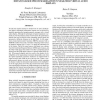Free Online Productivity Tools
i2Speak
i2Symbol
i2OCR
iTex2Img
iWeb2Print
iWeb2Shot
i2Type
iPdf2Split
iPdf2Merge
i2Bopomofo
i2Arabic
i2Style
i2Image
i2PDF
iLatex2Rtf
Sci2ools
101
click to vote
PRESENCE
2002
2002
Near-Field Virtual Audio Displays
In tasks that require listeners to monitor two or more simultaneous talkers, substantial performance benefits can be achieved by spatially separating the competing speech messages with a virtual audio display. Although the advantages of spatial separation in azimuth are well documented, little is known about the performance benefits that can be achieved when competing speech signals are presented at different distances in the near field. In this experiment, head-related transfer functions (HRTFs) measured with a KEMAR manikin were used to simulate competing sound sources at distances ranging from 12 cm to 1 m along the interaural axis of the listener. One of the sound sources (the target) was a phrase from the Coordinate Response Measure (CRM) speech corpus, and the other sound source (the masker) was either a competing speech phrase from the CRM speech corpus or a speech-shaped noise signal. When speech-shaped noise was used as the masker, the intelligibility of the target phrase inc...
Related Content
| Added | 23 Dec 2010 |
| Updated | 23 Dec 2010 |
| Type | Journal |
| Year | 2002 |
| Where | PRESENCE |
| Authors | Douglas Brungart |
Comments (0)

